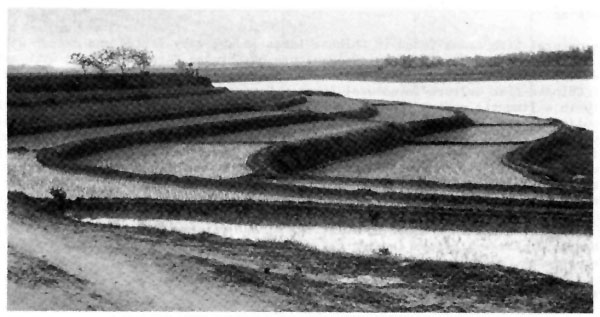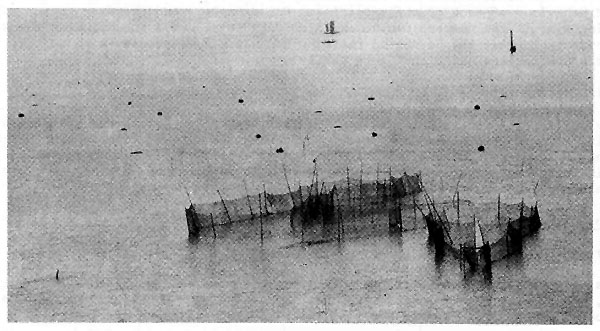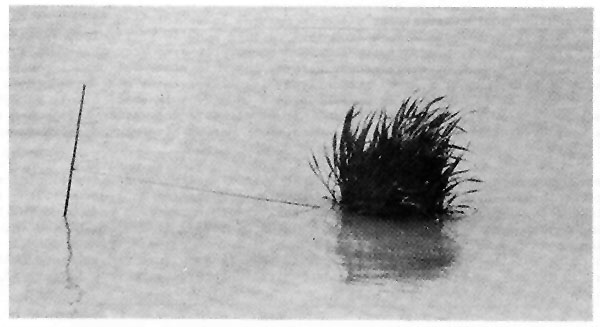In China, lakes are classified into three categories according to their surface area (ADCP, 1979):
Bodies of water of less than 1 000 mu in area are considered (for statistical purposes) as ponds.
The larger the surface area of a lake, the more extensive is its development and management. With a view to increasing fish production through fish culture management, more attention is focused on small lakes. This type of fish culture is particularly well-developed in the provinces of Chang Jiang Valley (e.g., Hubei, Anhui, Jiangsu and Zhejiang), where the best yields are obtained. The farming system however remains extensive, although in some cases, and only in lakes measuring some hundreds of hectares at most, organic fertilization (pig manure) and supplementary feeding (plants) are applied. The rates of application nevertheless remain much lower than those observed in fish ponds.
Development and management are collective activities which are carried out either at State level (State, district or municipality farm) or people's commune level (e.g., production brigade or people's commune itself). The aspect of the Chinese system which is particularly attractive, is that the same group is concerned with development and management. In the course of the year, the latter includes all fish culture activities, from initial stocking to final fishing. The results in an increasing sense of responsibility on the part of all members of the farming community who are directly concerned in the results of their own efforts.
Fish farming is not necessarily restricted to fish, but may also include other aquatic animals, such as crabs and shrimp at Tai Hu (Section 9.6). Fish farming moreover, usually includes other related aquatic activities, such as gathering and cultivation of aquatic plants (lotus, water hyacinth, rush, etc.), harvesting molluscs and removing organic silt. In addition, all these lake-based activities are closely linked with land farming activities which are carried out in the immediate vicinity of the lake, since it is easy to integrate all the different activities. At the Baitan Hu State Farm, for example, the study group was able to observe the following integrated activities: fish production in deep water, lotus production in shallow water, rice in marginal zones and mulberry/trees on the artificial dykes. Up to 20 percent of the total revenue from the lake is obtained from crops which are cultivated in combination with fish farming (Figure 54).
Development of natural lakes for fish culture generally includes the following activities:
Moreover, the current trend is to convert the shallower zones of natural lakes into large fish culture ponds, for more intensive fish culture. At Tai Hu, a dyke, built across a bay allowed 150 ha of lakeside land to be sub-divided into fish culture ponds.
The purpose of fish culture management is, if not to improve, at least to maintain fish culture production at an adequate level. During the course of the year, various operations are carried out, the principal ones being:

Figure 54 Agricultural development of the banks of the Baitan Hu, district of Huanggang, Hubei

Figure 55 Developed zone of the Tai Hu and fixed fishing gear. Wuxi, Jiangsu

Figure 56 Details of a clump of floating grass attached to a bamboo pole, in the developed zone of the Tai Hu, Wuxi, Jiangsu
(i) Stocking
The natural fish fauna found in Chinese lakes is not very varied and cannot utilize all the available natural resources. Polyculture of Chinese carps, combined with other fish species, allows these resources to be put to better use and this solution is at the basis of Chinese fish culture in natural lakes. However, river fish species do not spawn naturally in a limnetic environment and periodic stocking is necessary to maintain the fish population at an adequate level to allow regular fishing of stocks. Stocking is done once a year, usually in the spring, with locally produced fry. The size and the number of fingerlings stocked varies according to local production potential (Table 34). The present trend is to use fairly large fingerlings as far as possible, in order to reduce later mortality, and to increase stocking density. While formerly, less than 1 000 fingerlings of between 6 and 7 cm were stocked per hectare, today, attempts are being made to stock an average of at least 1 500 (and even 2 250) 15–20 cm fingerlings (weighing over 50 g). Usually the species chosen include at least two of the Chinese family carps and preferably the bighead and silver plankton feeding carps, as well as Wuchang bream, the crucian carp and other species, according to the trophic conditions of the lake.
(ii) Predator control
This is done only in small and medium lakes, where it is used to reduce the ichthyophagic fish populations (Siniperca chautsi, S. scherzeri and Elopichthys bambusa) as far as possible. The methods used are based mainly on the acquired knowledge of the life cycle and behaviour of each of these species. For example, when the fish gather together at spawning time, large numbers can be captured with seine nets; the spawners themselves can be destroyed; holes may be dug in the lake bed where some predators go to take refuge and can thus be located and fished more easily.
(iii) Fishing regulations
They may apply to the fishing season (protection of fish during the spawning season), the fishing grounds (protection of spawners), fishing gear (protection of fish weighing less than 0.5 kg) and fishing methods (no poison or explosives). Poaching appears to be unknown in China, but if it were to be discovered, it is more than probable that it would be severely condemned by the whole community.
(iv) Controlling the water level and maintaining the barriers/fences
(v) Harvesting of fish
This is done by successive fishing with trawls, purse seines, beach seines, gillnets, fykenets, traps, etc. Special techniques have been developed locally to enable the fish to be grouped together in certain parts of the lake, to facilitate harvesting.
The national annual average fish yield in natural lakes totalled 135 kg/ha in 1978 (Table 8). This yield however varies from lake to lake and, in particular, depends on the surface area. Indeed, productivity declines as surface area increases. This is a ratio that is equally well established for natural lakes in other regions of the globe. On the basis of this, annual average productivity in Chinese lakes was estimated in the past, by Tapiador, et al. (1978), as varying from 1 000 kg/ha in small lakes, to 225 kg/ha in medium lakes and 60 kg/ha in large lakes. It is probable that since 1976, when these estimates were made, improved fish culture management has resulted in an increase in average figures.
It would not appear however that total lake output has increased in a similar way, following the thrust given to more intensive farming methods (agriculture or fish) in shallow lake areas. Official statistics show that the total surface area used for fish cultivation in lakes recently declined from 531 100 ha (1978) to 484 793 ha (1979), i.e., a reduction of 46 307 ha in one year (Zhu De-Shan, 1980; Song, pers. comm., 1980). It is useful to point out that during the same period, pond fish culture was extended over an additional 32 173 ha and fish culture in reservoirs (Chapter 10), over a further 45 613 ha.
Table 34
Extensive fish culture in some natural lakes
| Lake (province) | Surface area (ha) | Average depth (m) | Main fish species | Stocking | Harvest | ||||
| Size (cm) | Number (million) | Density (fish/ha) | t/yearb | kg/ha | |||||
| A. | Small lakes | ||||||||
| Baitan Hu (Hubei) | 400 | 2.5 | Silver carp | 16–20 | 0.9 | 2 250 | 300 | 750 | |
| Bighead carp | |||||||||
| Xi Hu (Zhejiang) | 559 | 1.5 | Silver carp | 13 | 0.7 | 1 252 | 300 | 536 | |
| Bighead carp | max. 550 | max. 984 | |||||||
| B. | Medium lakes | ||||||||
| Tang/Esta (Hubei) | 1 467 | 4–5 | - | - | - | - | 660* | 450 | |
| Dianshan Hu (Shanghai) | 6 670 | max. 3 | - | 4–15 | 10 | 1 499 | 500 | 75 | |
| C. | Large lakes | ||||||||
| Tai Hu (Jiangsu) | 2 | Bighead carp | 10 | 10 | 47 | 11 980 | 56 | ||
| 226 700 | Silver carp | ||||||||
| (213 330) | Grass carp | ||||||||
| Black carp | |||||||||
a Ref. ADCP, 1979
b Figures for 1979, except * 1977
The harvests and yields obtained in some natural lakes are given in Table 34. Four of these lakes were visited by the writer during the study tour. So as to better illustrate the development and management procedures mentioned above, the more detailed information obtained on these visits is summarized above (Section 9.1). The lakes involved are, in order of magnitude: Baitan Hu, Hubei (400 ha); Xi Hu, Zhejiang (559 ha); Dianshan Hu, (6 670 ha) and Tai Hu, Jiangsu (226 700 ha). All are shallow; average depth does not exceed 5 m.
Development and management of Baitan Hu (district of Huanggang, Hubei) are among the activities of a State-owned farm, which specializes in fisheries and fish culture (Section 3.2). In 1979, its fry-rearing centre produced 50 million fry of 3 cm in length, 3 million of which were used by the farm itself, mostly to produce large fingerlings for stocking (16–20 cm) the lake. This Centre's output is relatively high and has been stable over the last seven years at 750 kg/ha/year. Prior to that, it was 450 kg/ha/year, when small fry of 6 cm were stocked at a density of approximately 1 500 specimens/ha only. Extensive polyculture includes 15 percent grass carps and a few Wuchang breams. The Centre is managed by 19 workers, under the supervision of technicians and senior staff. The current target is to increase output to 500 t/year.
Over the ages, the Xi Hu Lake, in the west (Hangzhon, Zhejiang) had become very shallow (0.55 m), swampy and covered with grass. In 1956, its annual output did not reach 20 t, i.e., approximately 35 kg/ha. That same year, restoration was undertaken and its average depth increased to 1.80 m by the removal of 7 million cubic metres of earth. A fishermen's cooperative was also set up. In 1959, a fish culture centre was set up to take charge of developing and managing fish culture activities in the lake and reforesting the watershed. A third activity, tourism, has since been developed in the region. This prompted the authorities concerned to look into the possible interactions of this activity with measures of conservation for the lake and its immediate surroundings.
The main features of the Xi Hu Lake can be summarized as follows:
Morphometry: watershed 2 122 ha; lake 603 ha, 559 ha of which is under water; shape, oval (2.8 × 3.3 km), circumference 15 km; bottom, flat; average depth (1979), 1.50 m maintained constant by means of a drainage weir at the northeast side;
Quality of water: temperature 20°C from April to October; dissolved oxygen 8–13 mg/litre; pH 8.4–9.6; dissolved salts 130 mg/litre; visibility depth 25–45 cm; eutrophic, and
Plankton: large quantities, most of it phytoplankton (average 43 mg/litre), more than 94 percent of which is made up of Microcystis.
Extensive polyculture is based on annual stocking of 13-cm long fingerlings of the silver carp (60 percent) and bighead carp (25 percent) species. Other species (common carp, Wuchang bream, crucian carp) are stocked at 7 cm. More than 50 different species are present in the lake. More than 110 persons are employed for management activities. Marketable size is fairly small (0.5–1 kg). Average annual production is 300 t, i.e., 536 kg/ha. In the past, however, it reached 550 t, i.e., 984 kg/ha.
The Dianshan Hu (district of Qingpu, Shanghai) is managed by the ‘Liberation’ People's Commune (Table 15). It is fed by 71 tributaries and its waters are poor in quality. In 10 years (1968–78), 10 of the natural species were lost because pollution of two main tributaries prevented migration. Decline in production to 320 t/year in 1977 was also due to other causes, such as closure of the communication system with the Chang Jiang, development of navigation and loss of aquatic plants. A research programme is underway (Shanghai Institute of Aquatic Products, Section 4.1.2). Since 1977, gradual improvements in fish culture management has already resulted in a rise in annual production, which reached 500 t (75 kg/ha) in 1979, i.e., a 56-percent increase in the last two years. Moreover, the mollusc harvest totals an average of several hundred kilogrammes per hectare (1976 = 450 kg/ha, according to Tapiador, et al., 1977).
China's third largest lake, the Tai Hu (Wuxi, Jiangsu), has a surface area of approximately 2 267 km2, 2 133 km2 of which is under water. This eutrophic lake, which is fed by the waters of the Chang Jiang and by several tributaries which originate in the surrounding mountains, has the following hydrobiological characteristics:
The Tai Hu is managed at provincial level by a Management Committee. This Committee meets periodically with the representatives of the groups concerned (people's communes, production brigades, universities, districts, etc.) to examine the most recently obtained information concerning the lake. Since several activities are carried out (fisheries, aquatic plants, molluscs, crop irrigation), management tends to promote each one and at the same time encourage integration. A major decision of the Management Committee concerns measures to ensure fishery development and the protection of the fishery environment.
Fishery development and management includes:
Aquatic products harvested in 1979 totalled 113 500 t, broken down as follows:
| (a) | Aquatic plants (particularly surface plants) and molluscs: 100 000 t; | ||||
| (b) | Fish | - | small cyprinids (maximum 20 cm): | 8 000 t | |
| - | from annual stocking: | 1 500 t | |||
| - | miscellaneous: | 2 480 t | |||
| Total | 11 980 t; | ||||
| (c) | Shrimp (Penaeus japonicus and white shrimp): 770 t, and | ||||
| (d) | Crabs: | 750 t. | |||
Average annual fish yield is relatively low, approximately 56 kg/ha, 66.8 percent of which is made up of small cyprinids (Coila ectenes), which have little market value. Stocked species account for only 12.5 percent of the fishery. The natural fauna (101 species) is so unbalanced in favour of this small cyprinid, that the only hope of increasing fish production lies in heavier stocking of Chinese carps. Between 1953 and 1979, stocking and improved management, combined, resulted in a rise in production of fish culture species from 5 500 t (1953) to 13 500 t (1979). Shrimp (especially Japanese shrimp, which does not spawn naturally in lakes) and crabs also made this output possible and careful management of their stocks is also extremely important.